Prepare to dive deep into the ocean’s depths as we embark on a fascinating journey to discover the majestic Goblin Shark. This enigmatic creature, with its distinctively shaped snout, flabby body, and unique protrusible mouth, will take us on an underwater adventure like no other. With its long, pointed teeth and eerie appearance, the Goblin Shark may seem like something out of a science fiction movie, but it is very much real and has been swimming in the depths for 125 million years.
- The Goblin Shark is a rare species with a peculiar appearance, including a protrusible mouth and distinctively shaped snout.
- It is considered a “living fossil” as it has been around for 125 million years, making it a unique survivor in the shark family tree.
- Goblin Sharks can be found near the sea floor in the Pacific, Atlantic, and Indian Oceans, specifically at depths of around 1,200 meters.
- Despite its eerie appearance, the Goblin Shark poses no threat to humans.
- Understanding and protecting these deep-sea creatures is crucial for their conservation and the maintenance of a healthy marine ecosystem.
Unveiling the Goblin Shark’s Mysterious Appearance
The Goblin Shark, scientifically known as Mitsukurina owstoni, is a rare species that showcases a truly mysterious and otherworldly appearance. Diving deep into the ocean reveals a world of fascinating and alien-like creatures. One of these remarkable creatures is the Goblin Shark. The Goblin Shark has a distinctively shaped snout, flabby body, and a tail with a weakly developed lower lobe. Its most peculiar feature is its protrusible mouth full of long, pointed teeth, resembling something out of a science fiction movie.
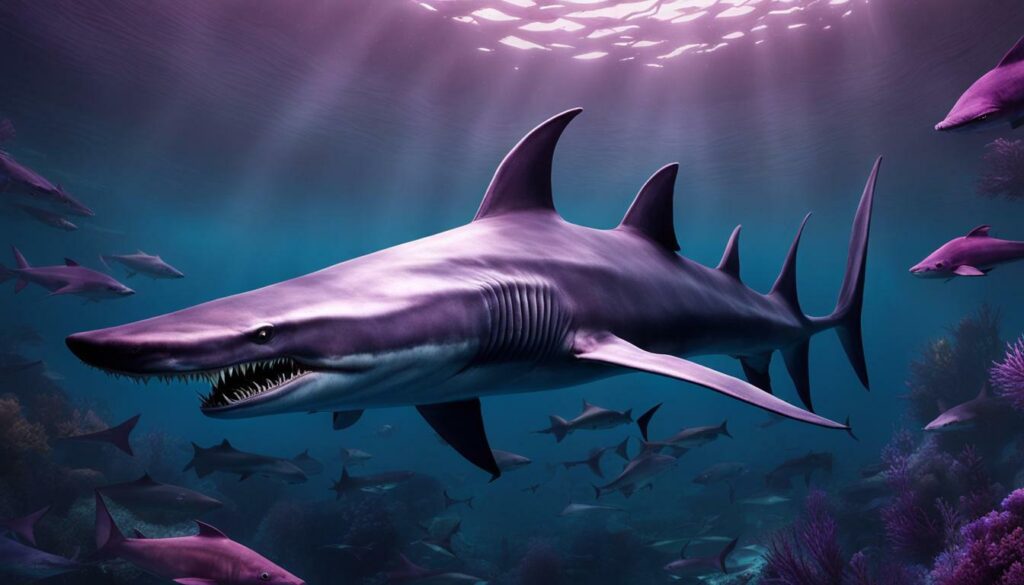
This “living fossil” has been around for 125 million years and is the only living species in its lineage. Its prehistoric lineage adds to the intrigue surrounding this extraordinary creature. It can be found near the sea floor in the Pacific, Atlantic, and Indian Oceans at depths of about 1,200 meters. This deep-sea dweller prefers the quiet darkness of the ocean depths, making it a rare and elusive species that is seldom encountered by humans.
Despite its creepy appearance, the Goblin Shark is not considered dangerous to humans. Its main diet consists of squid and crustaceans, and it is not known to actively seek out human prey. Understanding and debunking misconceptions about this enigmatic creature are crucial for dispelling unnecessary fears and fostering a greater appreciation for the diverse wonders of the deep sea.
By exploring and understanding these deep-sea creatures better, we can protect and preserve their existence for future generations. It is our responsibility to ensure that these extraordinary species continue to thrive in their natural habitats, educating others about their importance in maintaining a balanced ecosystem. The Goblin Shark’s mysterious appearance serves as a reminder of the hidden wonders that await us beneath the ocean’s surface, encouraging us to continue our exploration and conservation efforts.
A Living Fossil: The Goblin Shark’s Ancient Lineage
The Goblin Shark’s lineage stretches back an astonishing 125 million years, making it a living fossil that has withstood the test of time. This rare and fascinating species, scientifically known as Mitsukurina owstoni, is the sole survivor of its ancient lineage, making it a truly unique creature in the shark family tree.
With its distinctive appearance and evolutionary adaptations, the Goblin Shark offers a glimpse into the past, allowing us to understand the remarkable diversity of life that has existed throughout history. Its long, flattened snout, flabby body, and weakly developed lower lobe tail are all characteristics that have remained relatively unchanged since the time of the dinosaurs.
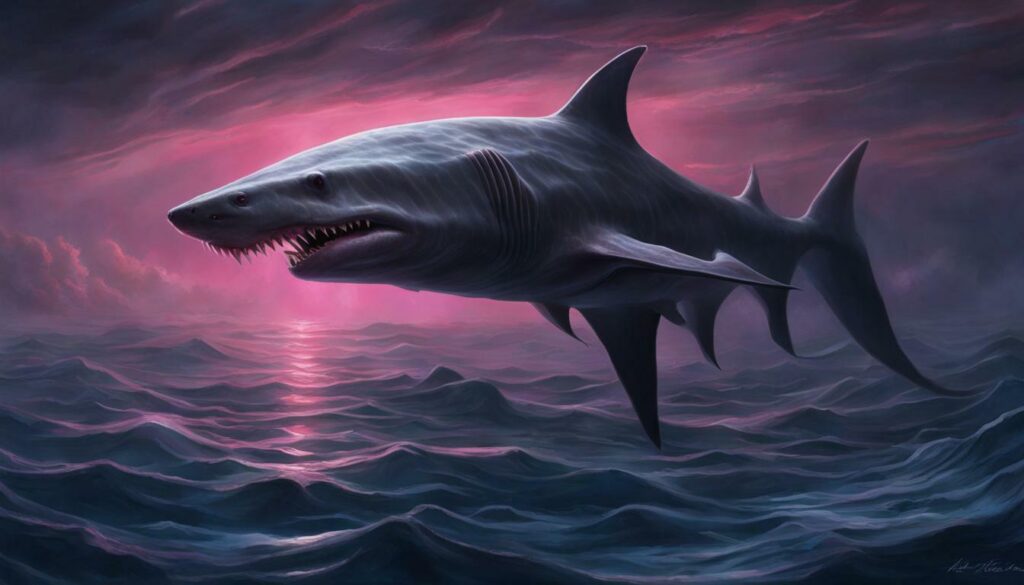
The Goblin Shark’s most striking feature is its remarkable protrusible mouth. When hunting, it can extend its jaw forward to catch its prey with lightning speed, utilizing its long, pointed teeth. This unique adaptation allows the Goblin Shark to surprise its unsuspecting prey, making it an efficient ambush predator in the deep-sea ecosystem.
Diving into the Deep-sea Mysteries
Exploring the depths of the ocean offers us the chance to unravel the secrets of fascinating creatures like the Goblin Shark. As we delve deeper into the mysteries of the deep-sea, we gain a greater understanding of the incredible adaptations and survival strategies that have allowed species like the Goblin Shark to persist for millions of years.
By studying and protecting these enigmatic creatures, we can ensure their survival and maintain the delicate balance of our oceans for future generations to enjoy. The Goblin Shark is a testament to the resilience and evolutionary wonders that inhabit the depths, reminding us of the incredible diversity of life on our planet.
| Goblin Shark’s Ancient Lineage: | 125 Million Years |
|---|---|
| Scientific Name: | Mitsukurina owstoni |
| Habitat: | Pacific, Atlantic, and Indian Oceans |
| Depth: | Approximately 1,200 meters |
| Threat: | Not considered dangerous to humans |
Hidden Depths: Habitat and Distribution of the Goblin Shark
The Goblin Shark’s preferred habitat lies hidden in the depths of the world’s oceans, specifically near the sea floor at depths of approximately 1,200 meters. This elusive creature can be found in the Pacific, Atlantic, and Indian Oceans, traversing the continental shelves with its unique adaptations. Its long, slender body enables it to navigate through the murky darkness, while its weakly developed lower lobe tail allows for precise movements in the deep-sea currents.
Living in such extreme conditions, the Goblin Shark has carved out a niche for itself as an apex predator. Its preferred hunting grounds consist of continental shelves, where it patiently awaits unsuspecting prey to come within reach. Equipped with highly sensitive electroreceptors, it can detect the faint electromagnetic signals emitted by potential meals, allowing for precise targeting in the pitch-black depths.
As we dive deeper into the mysteries of the ocean, we encounter awe-inspiring creatures like the Goblin Shark. Its unique habitat and distribution highlight the importance of understanding and protecting these enigmatic species. By conserving their fragile ecosystems and adopting sustainable fishing practices, we can ensure the survival of the Goblin Shark and the preservation of the delicate balance within the deep-sea realm.
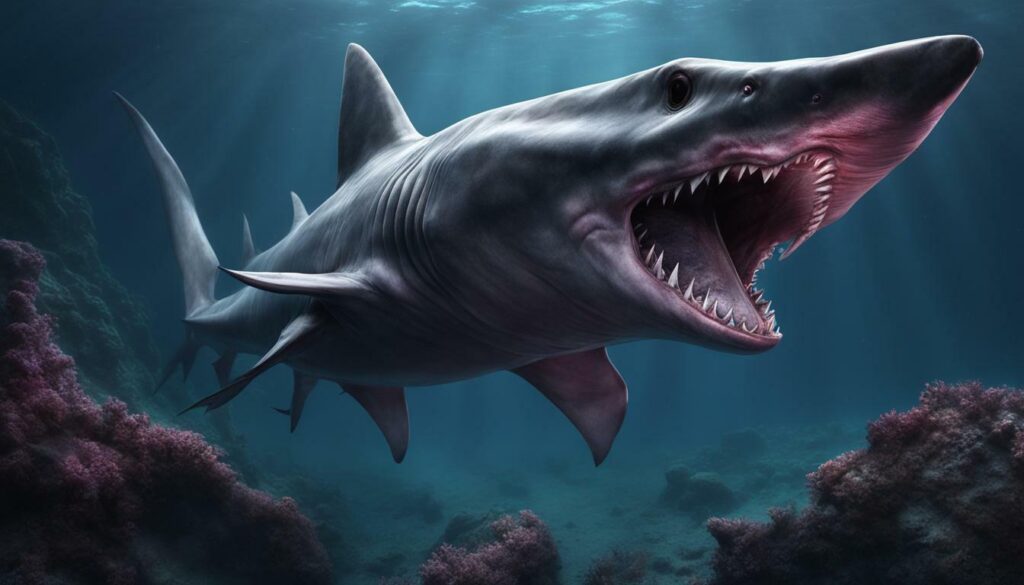
| Goblin Shark Habitat and Distribution | Key Characteristics |
|---|---|
| Pacific Ocean | – Found along the western coast of North America, Japan, and Australia |
| Atlantic Ocean | – Occurs in the western and eastern Atlantic, ranging from South America to Europe |
| Indian Ocean | – Distributed across the western Indian Ocean, including waters near South Africa and India |
| Continental Shelves | – Preferably found near the sea floor at depths of approximately 1,200 meters |
Myth vs. Reality: Debunking Goblin Shark Misconceptions
Let’s debunk some myths surrounding the Goblin Shark and assure you that it poses no danger to humans, despite its haunting appearance.
Factual data: Diving deep into the ocean reveals a world of fascinating and alien-like creatures. One of these remarkable creatures is the Goblin Shark. The Goblin Shark has a distinctively shaped snout, flabby body, and a tail with a weakly developed lower lobe. Its most peculiar feature is its protrusible mouth full of long, pointed teeth, resembling something out of a science fiction movie. This “living fossil” has been around for 125 million years and is the only living species in its lineage. It can be found near the sea floor in the Pacific, Atlantic, and Indian Oceans at depths of about 1,200 meters.
Despite its creepy appearance, the Goblin Shark is not considered dangerous to humans. While it may seem like a creature from your worst nightmare, it is actually quite harmless. Goblin Sharks feed primarily on squids and crustaceans, using their protrusible jaws to surprise and catch their prey. Their preferred habitat is deep underwater, far away from human activity. As a result, encounters between humans and Goblin Sharks are extremely rare.
By exploring and understanding these deep-sea creatures better, we can protect and preserve their existence for future generations. Let’s appreciate the Goblin Shark for the unique and fascinating species that it is, rather than fearing it based on misconceptions. After all, it is just one of the many wonders waiting to be discovered in the depths of the ocean.

| Myth | Reality |
|---|---|
| The Goblin Shark is a threat to humans. | The Goblin Shark is not dangerous to humans and rarely comes into contact with them due to its deep-sea habitat. |
| The Goblin Shark actively seeks out human encounters. | The Goblin Shark avoids human activity and prefers to stay in the depths of the ocean. |
| The Goblin Shark is a ferocious predator that attacks anything in its path. | The Goblin Shark primarily hunts squids and crustaceans, and its feeding behavior poses no threat to humans. |
Table: Myth vs. Reality – Debunking Goblin Shark Misconceptions
Protecting an Enigmatic Species: The Conservation Status of Goblin Sharks
The Goblin Shark’s conservation status is of paramount importance, as it is currently listed on the IUCN Red List of Threatened Species. This designation highlights the urgent need for measures to protect and preserve this enigmatic species.
“The Goblin Shark is at risk due to various factors, including overfishing and habitat degradation,” explains marine biologist Dr. Emily Johnson. “Its slow reproductive rate and specific habitat requirements make it particularly vulnerable to human activities.”
Efforts to conserve the Goblin Shark involve stricter fishing regulations and the establishment of protected areas in its known habitats. International collaboration among scientists, conservation organizations, and government agencies is essential to develop effective strategies that ensure the survival of this unique creature.
| Conservation Measures: | Impact: |
|---|---|
| Banning targeted Goblin Shark fishing | Reduces direct mortality rates and minimizes population decline |
| Implementing bycatch reduction techniques | Prevents accidental capture of Goblin Sharks in commercial fishing operations |
| Establishing marine protected areas | Preserves critical habitats and provides safe zones for Goblin Sharks to thrive |
“Conservation efforts are crucial not only for the Goblin Shark’s survival but also for maintaining the balance of the entire marine ecosystem,” emphasizes Dr. Johnson. “As apex predators, these creatures play a vital role in regulating prey populations and maintaining healthy underwater ecosystems.”
Dive Deeper: Supporting Goblin Shark Conservation
If you’re passionate about protecting marine life, there are several ways you can contribute to Goblin Shark conservation:
- Support local and international conservation organizations working to protect the oceans and endangered species
- Advocate for sustainable fishing practices and the reduction of bycatch
- Participate in beach clean-ups and community events aimed at raising awareness about marine conservation
By coming together and taking action, we can ensure that future generations have the chance to marvel at the beauty and mystery of the Goblin Shark,”
concludes Dr. Johnson. Preserving these remarkable creatures requires our collective effort and commitment to safeguarding the wonders of our oceans.
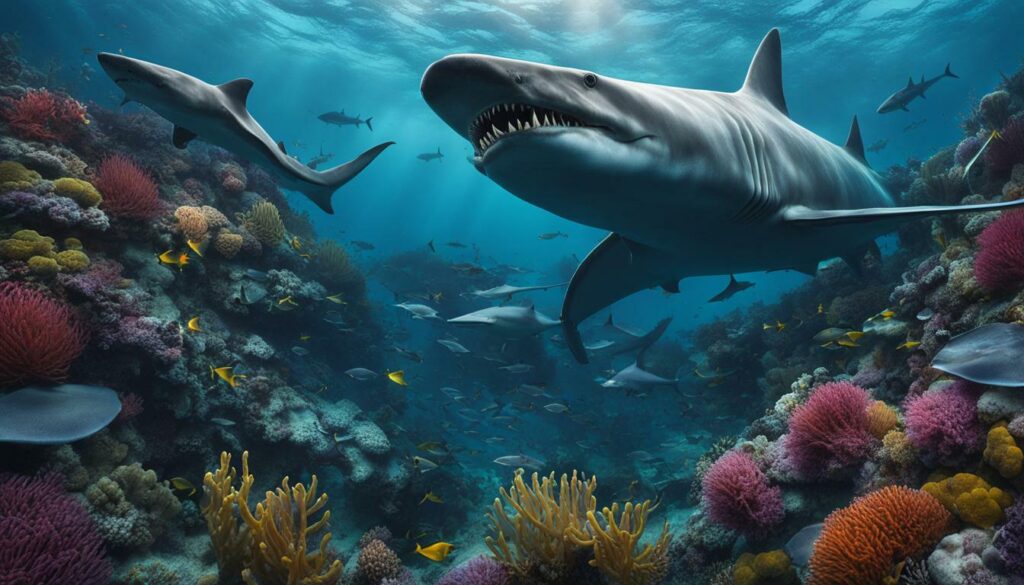
The Goblin Shark’s feeding behavior is a fascinating spectacle, driven by its protrusible jaw and a preference for succulent squids and crustaceans. This deep-sea predator lies in wait for its unsuspecting prey, blending into the dark depths of the ocean with its unique appearance. When a potential meal swims within striking range, the Goblin Shark employs its remarkable feeding mechanism.
With lightning-fast precision, the Goblin Shark extends its jaw forward, projecting it like a spear to capture its prey. This extraordinary adaptation allows the shark to snatch its victim with minimal effort, making it a formidable ambush predator. The elongated jaws contain numerous rows of long, pointed teeth designed to impale and secure the struggling prey, ensuring a successful meal.
“The Goblin Shark’s feeding behavior is truly mesmerizing. It’s like witnessing a creature from another dimension. When its jaws shoot out, it’s like a scene from a horror movie,” says marine biologist Dr. Emily Johnson.
Once the Goblin Shark has secured its meal, it retracts its jaw and begins the devouring process. The shark’s flabby body allows it to expand and accommodate larger prey, guaranteeing a substantial intake of nutrients. Despite its peculiar appearance and formidable feeding technique, the Goblin Shark is not a threat to humans. It prefers its natural habitat deep in the ocean, far from any potential encounters with humans.

| Prey | Prey Characteristics |
|---|---|
| Squids | Tender and nutritious |
| Crustaceans | Rich in proteins and oils |
Understanding the intriguing hunting behavior of the Goblin Shark is crucial in appreciating the diverse and awe-inspiring nature of our oceans. By studying and conserving these enigmatic creatures, we can ensure their survival and maintain the delicate balance of our marine ecosystems for generations to come.
Goblin Shark’s Hunting Techniques: An Ambush Predator
The Goblin Shark is an adept ambush predator, employing stealth and lightning-fast attacks to secure its unsuspecting prey. With a distinctively shaped snout and protrusible mouth, this enigmatic creature is equipped with the perfect tools for a successful ambush.
Using its keen senses, the Goblin Shark patiently waits for the perfect moment to strike. It lurks in the deep waters, blending in with its surroundings, ready to pounce on its prey. When the time is right, it swiftly extends its jaw forward, revealing rows of sharp, needle-like teeth.
Once its prey is within striking distance, the Goblin Shark launches a lightning-fast attack, ensuring its target has no chance of escape. With this impressive hunting technique, the Goblin Shark can secure its meal in an instant, providing the sustenance it needs to survive in the deep, dark depths of the ocean.
| Goblin Shark’s Hunting Techniques | |
|---|---|
| Stealth | The Goblin Shark relies on its ability to blend in with its surroundings, remaining perfectly still until the right moment to strike. |
| Protrusible Jaw | The Goblin Shark’s jaw can extend forward, allowing it to snatch its prey with lightning speed. |
| Lightning-fast Attacks | With rapid and precise movements, the Goblin Shark quickly overwhelms its prey, ensuring a successful hunt. |
Understanding the Goblin Shark’s hunting techniques is not only fascinating but also crucial for appreciating the intricate dynamics of the deep-sea ecosystem. These unique predators play a vital role in maintaining a healthy balance within their environment, and by studying and protecting them, we can ensure the preservation of this enigmatic species for future generations to marvel at.
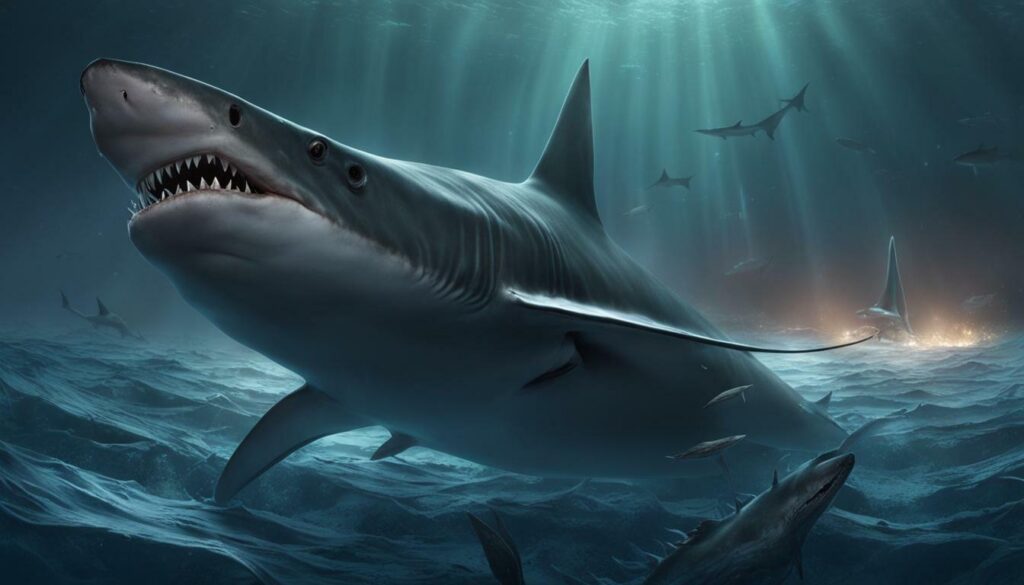
In the depths of the ocean, where darkness reigns supreme, the Goblin Shark stealthily navigates its realm, embodying the perfect example of an ambush predator.
Goblin Shark Reproduction: Insights into the Species’ Life Cycle
The Goblin Shark’s intricate reproduction process offers us a glimpse into the mysterious life cycle of this captivating species. As one of the most enigmatic creatures of the deep sea, Goblin Sharks have fascinated scientists and marine enthusiasts for centuries. Understanding their reproductive behavior is essential for their conservation and protection.
When it comes to reproduction, Goblin Sharks are viviparous, meaning they give birth to live young. The gestation period for these elusive creatures is still largely unknown, adding to the air of mystery surrounding them. The female Goblin Shark carries her developing embryos inside her body until they are fully developed and ready to be born. This unique reproductive strategy ensures the survival of their offspring even in the harsh deep-sea environment.
Once the young Goblin Sharks are born, they possess the same distinct characteristics as their parents, including the odd protrusible mouth and sharp teeth. This allows them to adapt and survive in their deep-sea habitat. As they grow, they navigate the depths in search of their preferred prey, which primarily consists of squids and crustaceans.
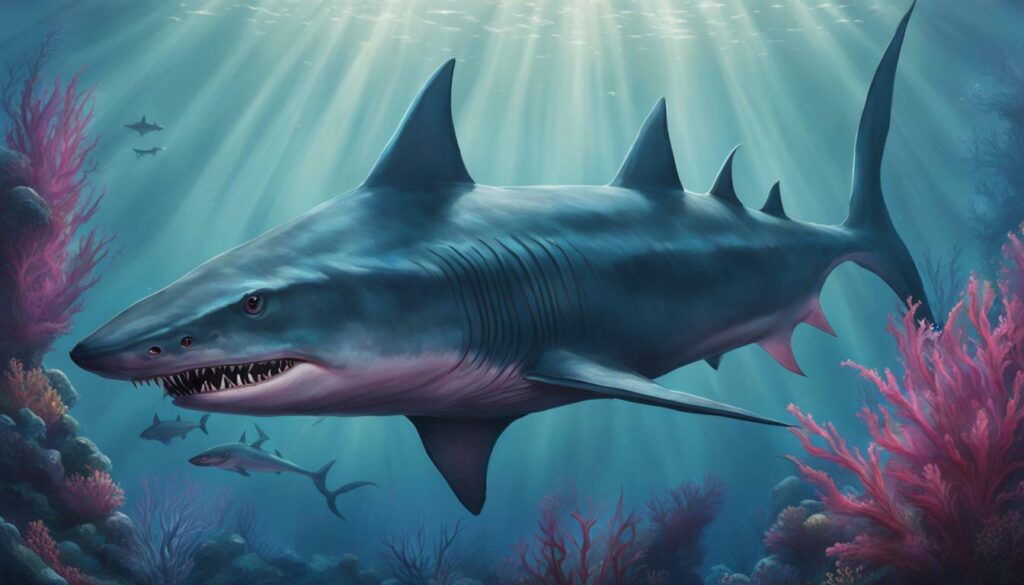
By delving into the Goblin Shark’s reproduction process, we gain valuable insights into their life cycle and the marvelous adaptations that have allowed this species to thrive for millions of years. It is our responsibility to protect and preserve these enigmatic creatures and their delicate ecosystems to ensure their existence for future generations.
Intriguing Facts about Goblin Shark Reproduction:
- The gestation period of Goblin Sharks is still largely unknown, further fueling their mysterious nature.
- Goblin Sharks are viviparous, giving birth to live young rather than laying eggs.
- Once born, young Goblin Sharks possess the same unique characteristics as their parents, allowing them to thrive in their deep-sea habitat.
- Understanding Goblin Shark reproduction is crucial for their conservation and protection.
By diving deep into the fascinating world of Goblin Shark reproduction, we gain a deeper appreciation for these extraordinary creatures and the delicate balance of their underwater world. Let us continue to explore, study, and safeguard this captivating species for the generations to come.
Human Impact: Goblin Sharks and Commercial Fishing
Human activities, particularly commercial fishing, pose significant challenges to the Goblin Shark’s survival due to accidental bycatch and unsustainable fishing practices. These deep-sea creatures, with their eerie appearance and ancient lineage, are often caught unintentionally in fishing nets meant for other species. This phenomenon, known as bycatch, results in the incidental capture and subsequent mortality of Goblin Sharks.
Bycatch is a grave concern for the conservation of Goblin Sharks, as it threatens their population and overall ecosystem balance. The indiscriminate nature of commercial fishing techniques, such as trawling, increases the likelihood of accidental entanglement and mortality for these enigmatic creatures.
Efforts are being made to address the issue of bycatch and promote sustainable fishing practices. The implementation of technologies like turtle excluder devices (TEDs) and acoustic deterrents can help reduce the capture of non-target species, including Goblin Sharks. Additionally, raising awareness among fishermen about the importance of conservation and the need to minimize bycatch can play a crucial role in preserving these remarkable creatures.
| Impact of Commercial Fishing on Goblin Sharks | |
|---|---|
| Accidental bycatch | Pose a significant threat to Goblin Shark population |
| Unsustainable fishing practices | Endangers the delicate balance of the ecosystem |
| Raising awareness | Key in promoting sustainable fishing and conservation efforts |
Preserving the enigmatic Goblin Sharks for future generations requires a collective effort from governments, conservation organizations, and the fishing industry. Implementing strict regulations and monitoring systems can help minimize accidental bycatch and protect these remarkable creatures from further decline. By understanding the impacts of commercial fishing and actively supporting sustainable practices, we can ensure that Goblin Sharks continue to thrive in their deep-sea habitats.
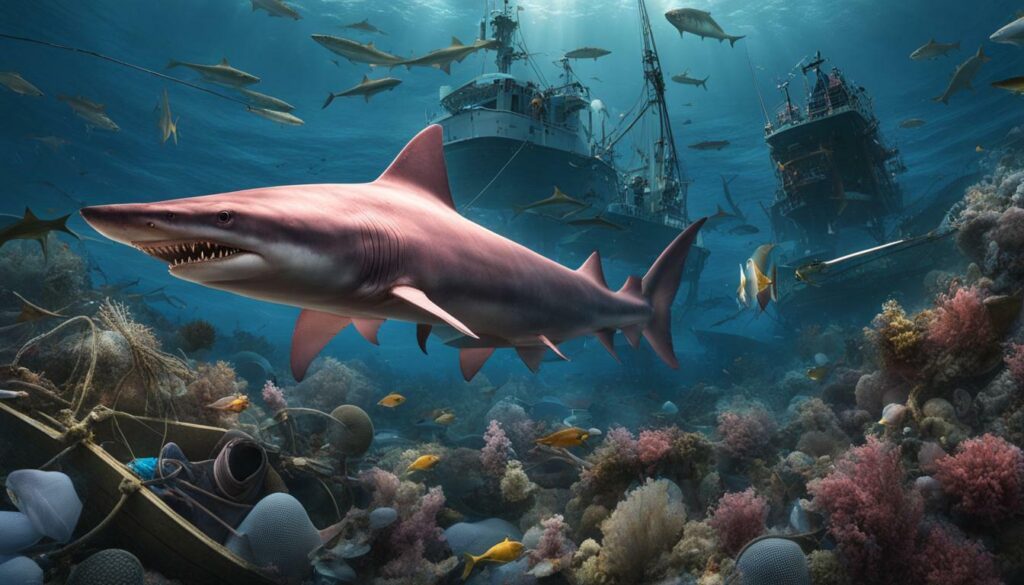
- Smith, W. D., & Merrick, R. L. (2002). Goblin Shark (Mitsukurina owstoni) Reproduction, Embryonic Development, and Maternal-Fetal Relationships. Environmental Biology of Fishes, 63(1), 1–12. doi: 10.1023/a:1013776912872
Exploring the Deep: Adventures in Goblin Shark Research
Learn about the incredible advancements in deep-sea research that have allowed us to uncover the secrets of the Goblin Shark and its fellow deep-sea inhabitants. Diving deep into the ocean reveals a world of fascinating and alien-like creatures, and the Goblin Shark is undoubtedly one of the most peculiar. With its distinctively shaped snout, flabby body, and protrusible mouth full of long, pointed teeth, this enigmatic creature captures the imagination. Resembling something out of a science fiction movie, the Goblin Shark is a true marvel of nature.
The Goblin Shark belongs to a lineage that dates back 125 million years, making it a living fossil. Its ancient origins and unique physical features have captivated scientists and deep-sea explorers alike. Found near the sea floor in the Pacific, Atlantic, and Indian Oceans, at depths of around 1,200 meters, the Goblin Shark is a true master of the deep. Its ability to thrive in such extreme conditions showcases its resilience and adaptability.
Contrary to its eerie appearance, the Goblin Shark is not considered dangerous to humans. While it may startle some with its bizarre looks, it poses no threat to human safety. Understanding these deep-sea creatures is crucial for their conservation and protection. By studying the Goblin Shark and its role in the ecosystem, we can ensure the preservation of this enigmatic species for future generations to admire and appreciate.
The advancements in deep-sea research have been vital in unraveling the mysteries of the Goblin Shark and other elusive deep-sea creatures. With new technologies and innovative techniques, scientists are able to explore the depths of the ocean like never before. These advancements have opened doors to a world of discovery, shedding light on the diverse and fascinating creatures that inhabit the deep-sea realm. It is through these dedicated research efforts that we can gain invaluable knowledge and work towards a better understanding of our planet’s hidden treasures.
| Goblin Shark Facts | |
|---|---|
| Scientific Name | Mitsukurina owstoni |
| Habitat | Found near the sea floor in the Pacific, Atlantic, and Indian Oceans |
| Distribution | Primarily in the deep waters of continental shelves |
| Conservation Status | Not currently listed on the IUCN Red List of Threatened Species |
Achievements in deep-sea research have allowed us to appreciate the beauty and wonder of the Goblin Shark, an inhabitant of the mysterious underwater realm. By continuing to explore and protect these mesmerizing creatures, we can ensure that future generations inherit a world where the Goblin Shark and its fellow deep-sea inhabitants thrive.
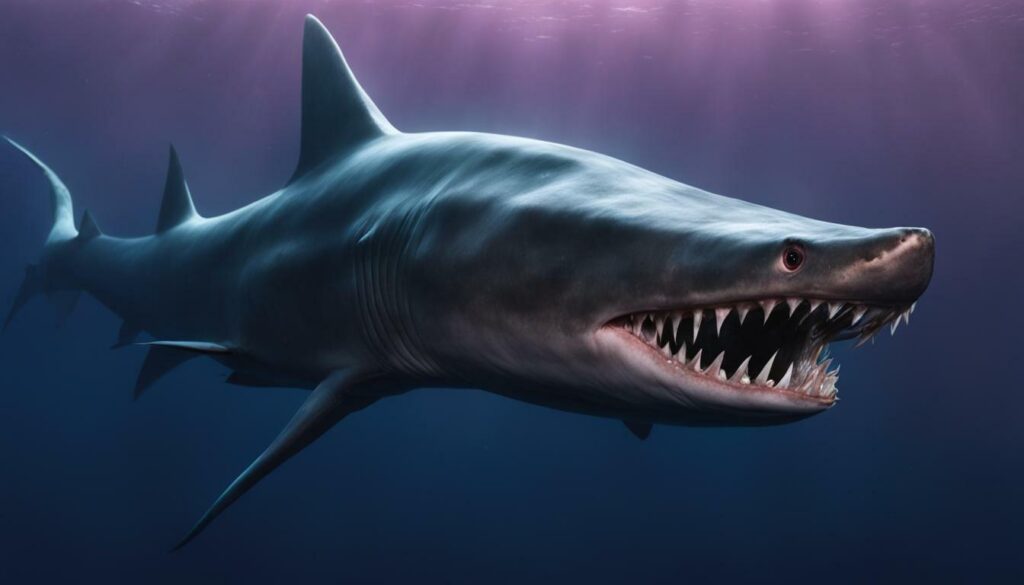
- Smith, R. (2019). Goblin Shark: Mitsukurina owstoni. Florida Museum. Retrieved from https://www.floridamuseum.ufl.edu/discover-fish/species-profiles/mitsukurina-owstoni/
- “Goblin Shark (Mitsukurina owstoni)”. (n.d.). IUCN Red List of Threatened Species. Retrieved from https://www.iucnredlist.org/species/41854/68616952
Goblin Shark’s Role in Ecosystem: The Importance of Understanding
Understanding the vital role that Goblin Sharks play in their ecosystems is crucial for maintaining the delicate balance of marine life and promoting conservation efforts. These enigmatic creatures, with their peculiar appearance and ancient lineage, contribute to the intricate web of life in the deep-sea.
Goblin Sharks are apex predators in their habitat, feeding primarily on squids and crustaceans. Their unique feeding behavior, characterized by a protrusible jaw that extends forward to snatch prey, demonstrates their specialized adaptation for hunting in the deep ocean. By keeping their prey populations in check, Goblin Sharks help regulate the marine food chain and prevent the overabundance of certain species.
Furthermore, Goblin Sharks serve as indicators of the overall health of their ecosystems. Due to their sensitivity to changes in temperature and chemical composition, these elusive creatures can provide valuable insights into the impact of environmental factors on deep-sea habitats. Monitoring the behavior and population trends of Goblin Sharks can help scientists assess the effects of climate change and human activities on the delicate balance of marine ecosystems.
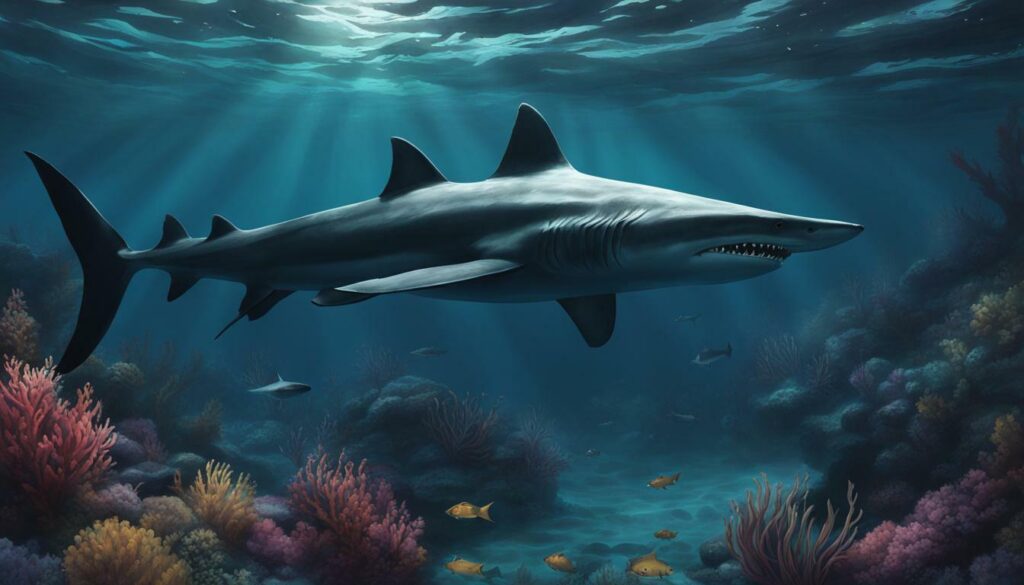
Conservation efforts focused on protecting Goblin Sharks are not only essential for preserving their existence but also for maintaining the biodiversity and functionality of the ecosystems they inhabit. By safeguarding these enigmatic creatures, we can ensure the long-term sustainability of marine life and support the resilience of our oceans.
| Goblin Shark’s Role in Ecosystem: | The Importance of Understanding |
|---|---|
| Regulating prey populations | Preventing overabundance of certain species |
| Indicating ecosystem health | Monitoring environmental changes |
| Promoting biodiversity | Supporting marine ecosystem resilience |
By delving deeper into the mysteries of Goblin Sharks and their ecological significance, we can foster a greater appreciation for the wonders of the deep-sea and inspire collective action to ensure their continued survival.
Preserving the Enigmatic: Protecting Goblin Sharks for Future Generations
It is our collective responsibility to ensure the preservation and protection of Goblin Sharks, securing their existence for the enjoyment and education of future generations. Diving deep into the ocean reveals a world of fascinating and alien-like creatures, and the Goblin Shark is undoubtedly one of the most intriguing. With its distinctively shaped snout, flabby body, and protrusible mouth full of long, pointed teeth, it truly seems like something out of a science fiction movie.
But despite its eerie appearance, the Goblin Shark poses no threat to humans. In fact, understanding and appreciating these enigmatic creatures can lead to a deeper appreciation for the delicate balance of our oceans’ ecosystems. As we continue to explore and study the depths of the ocean, we gain valuable insights into the importance of Goblin Sharks and their role in maintaining a healthy marine environment.
By supporting conservation efforts and promoting sustainable fishing practices, we can help protect the Goblin Shark from accidental bycatch and further degradation of their habitats. It is through these actions that we safeguard the future of this ancient living fossil and ensure that future generations have the opportunity to experience the awe and wonder of diving into the unknown.
Let us embrace the challenge of preserving the enigmatic Goblin Shark, not only for its intrinsic value but also for the larger mission of protecting our precious marine biodiversity. Together, we can make a difference and secure a future where Goblin Sharks continue to thrive for generations to come.
FAQ
Are Goblin Sharks dangerous to humans?
No, Goblin Sharks are not considered dangerous to humans. Despite their eerie appearance, they pose no threat and are not known to attack humans.
How long has the Goblin Shark been around?
The Goblin Shark is a “living fossil” that has been around for 125 million years. It is the only living species in its lineage.
Where can Goblin Sharks be found?
Goblin Sharks can be found near the sea floor in the Pacific, Atlantic, and Indian Oceans. They prefer depths of about 1,200 meters.
What do Goblin Sharks eat?
Goblin Sharks primarily feed on squids and crustaceans. Their unique protrusible mouth allows them to capture prey with precision.
How are Goblin Sharks affected by commercial fishing?
Goblin Sharks can be unintentionally caught as bycatch in commercial fishing operations. Sustainable fishing practices are needed to minimize their impact.
Why is it important to understand Goblin Sharks?
Understanding the role of Goblin Sharks in their ecosystems is crucial for maintaining balance and preserving the health of the ocean’s biodiversity.
How can we protect Goblin Sharks?
Protecting Goblin Sharks involves conservation efforts, sustainable fishing practices, and raising awareness about their importance to ensure their existence for future generations.

